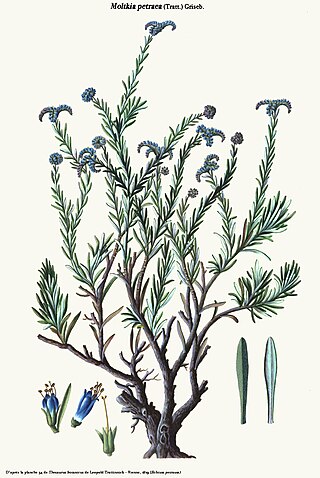
Royal Botanic Gardens, Kew is a non-departmental public body in the United Kingdom sponsored by the Department for Environment, Food and Rural Affairs. An internationally important botanical research and education institution, it employs 1,100 staff. Its board of trustees is chaired by Dame Amelia Fawcett.

The Chenopodioideae are a subfamily of the flowering plant family Amaranthaceae in the APG III system, which is largely based on molecular phylogeny, but were included – together with other subfamilies – in the family Chenopodiaceae, or goosefoot family, in the Cronquist system.

Chenopodium is a genus of numerous species of perennial or annual herbaceous flowering plants known as the goosefoot, which occur almost anywhere in the world. It is placed in the family Amaranthaceae in the APG II system; older classification systems, notably the widely used Cronquist system, separate it and its relatives as Chenopodiaceae, but this leaves the rest of the Amaranthaceae polyphyletic. However, among the Amaranthaceae, the genus Chenopodium is the namesake member of the subfamily Chenopodioideae.

Ravenea albicans is a species of flowering plant in the Arecaceae family. It is a palm endemic to northeast Madagascar and found in seven fragmented locations between the towns of Ampasimanolotra and Antalaha with the exception of one location much farther south near Vondrozo. It is an endangered species threatened by habitat loss. There are perhaps 200 mature individuals remaining. In its natural range it tends to grow in humid forests within northeast Madagascar's mountain valleys. It is unique among the Ravenea genus because its pinnate leaves have an exotic, colorful appearance. Its species name, albicans, is derived from the Latin word for the color white, album, as is the word for albinism. The base of each frond is green, yet they become white to dark grey near the tip at maturity. Some individuals have completely white fronds.

Sesleria is a genus of perennial plants in the grass family. They are native to Eurasia and North Africa. They are found in Albania, Austria, Baleares, Baltic States, Belarus, Belgium, Bulgaria, Corsica, Czechoslovakia, East Aegean Islands, Finland, France, Germany, Great Britain, Greece, Hungary, Iceland, Iran, Ireland, Italy, Crete, Crimea, Lebanon, Morocco, North Caucasus, Poland, Romania, Sardina, Sicilia, Spain, Sweden, Switzerland, Syria, Transcaucasus, Turkey, Ukraine and Yugoslavia.

Halothamnus lancifolius is a species of the plant genus Halothamnus, that belongs to the subfamily Salsoloideae within the family Amaranthaceae,. It occurs in Southwest Asia.

Veronica albicans, synonym Hebe albicans, is a species of flowering plant in the family Plantaginaceae, native to New Zealand.

Dysphania is a genus of plants in the family Amaranthaceae. Species of the genus are found worldwide from the tropics and subtropics to warm-temperate regions.

Halimione is a plant genus from the subfamily Chenopodioideae of the family Amaranthaceae. It is a sister genus of Atriplex and is included in that genus by Plants of the World Online.

Moltkia is a genus in the family Boraginaceae with 6 accepted species. They are herby semi-bushes (shrubs) with dark green hairy leaves and hanging groups of tube-shaped flowers. The species occur in the south of Europe and western Asia, where they are sparely hardy.

Holigarna is a genus of trees in the subfamily Anacardioideae of the cashew and sumac family Anacardiaceae. They grow naturally in India, Bangladesh and Indo-China. This is a poisonous tree; if contacted, it would irritate skin chemically and result in irreversible skin damage. Smoke from burning this wood is dangerously disabling.
Plants of the World Online (POWO) is an online database published by the Royal Botanic Gardens, Kew. It was launched in March 2017 with the ultimate aim being "to enable users to access information on all the world's known seed-bearing plants by 2020". The initial focus was on tropical African Floras, particularly Flora Zambesiaca, Flora of West Tropical Africa and Flora of Tropical East Africa.

Anthochlamys is a genus of flowering plants belonging to the family Amaranthaceae.
Brookea is a genus of flowering plant belonging to the family Plantaginaceae.
Cyathobasis fruticulosa is a species of flowering plant belonging to the family Amaranthaceae. It is the sole species in genus Cyathobasis. It is a subshrub native to Turkey.
Pycnocycla is a genus of flowering plants belonging to the family Apiaceae.

Horaninovia is a genus of flowering plants belonging to the family Amaranthaceae. It also belongs to the tribe Salsoleae as well as in the subfamily Salsoloideae.

Exomis is a genus of flowering plants belonging to the family Amaranthaceae. It just contains one species, Exomis microphylla(Thunb.) Aellen It is also in the Chenopodioideae subfamily.

Cyathopsis albicans is a species of plant in the family Ericaceae, endemic to New Caledonia. It was first described as Leucopogon albicans in 1864 by Adolphe-Théodore Brongniart and Jean Antoine Arthur Gris, and transferred to Cyathopsis in 2005 by Christopher John Quinn.
Oxossia albicans is a subshrub in the genus Oxossia. It is native to the wet tropics of eastern Brazil, specifically the Atlantic forest.














